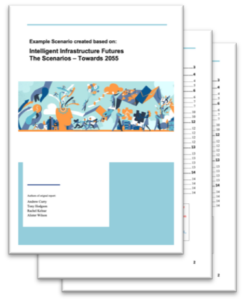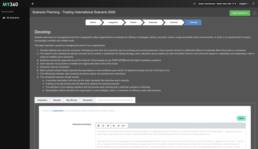
Scenario Planning Tool Scenarios360
We are proud to announce the launch of our new Scenario Planning Tool Scenarios360™. This online tool will complete our suite of innovation and growth tools — global key drivers via scenarios and strategic initiatives with ideation360®, ideation management and change cultivation and implementation with InnoSurvey®, and skill assessment with InnoComp™. All of these powerful innovation management tools are now at your fingertips as accredited, certified, licensed practitioners in innovation management and growth.
Scenarios360™, a modern Scenario Planning Tool, is built upon the UK manual and the Shell Scenario toolkit for scenario analysis. Utilizing insight gained from PESTLED analysis, scenario planning helps to elaborate on different possibilities.
The Scenario Planning Tool six-step process
One: Identity possible issues linked to the driving force or forces raised by PESTLED analysis―no more than two to three for the sake of clarity.
Two: Specify a time frame―for instance, three years from now.
Three: Define two or three extreme potential outcomes within the given time frame. After combining the issues in all possible combinations, pinpoint a few interesting scenarios for deeper investigation.
Four: List all stakeholders involved in each scenario. Examine to understand their impact, as well as the impact of each force or forces upon them. For instance, the stakeholders could be future competitors or collaborators, and a force could be competition from new entrants.
Five: Work backward in order to understand possible plots or key drivers that may signal that a scenario is about to happen.
Six: Analyze the recommendations derived from each scenario. As time passes, these scenarios can be reiterated and adjusted as needed.
Screenshots and videos of PESTLED360 and the Scenario Planning Tool SCENARIO360


Let’s Work Through an Example Together
Imagine that you sit on the leadership team of a top-five executive jet rental company, such as Netjets or GlobeAir. Your profits depend upon maximizing asset usage, keeping low crew costs, and maximizing add-on express cargo.
This scenario plan is based on the following key global drivers:
- Elon Musk has launched a fleet of functional electric jets;
- The cost structure is estimated to be as low as $0.09 per seat mile, or $260 per hour;
- Ticket prices are one-third the current market rate, with an 80 percent reduction of emissions and noise; and
- Office-to-office time has been reduced by half.
One: Major players cannot compete on short-haul, but the new airline can’t handle all the demand. So, expect new entrants.
Two: Imagine ourselves three years from now, when we’ve navigated through regulatory hurdles.
Three: Envision an extreme, yet plausible scenario, where environmental concerns lead to the banning of combustion engines.
Four: You’ll populate this section with your fantasy stakeholders, and it could become quite extensive in a real scenario innovation plan.
Five: Work backward into partnerships, new business models, and/or liquidation plans.
Strategic Initiatives with Scenarios360™
With an understanding of PESTLED outcomes, organizations can explore the ways in which these findings will impact future strategy and the formation of strategic initiatives. Scenarios360™ prioritizes Operational Strategic Initiatives for immediate execution, enabling incremental innovation through Impact-Feasibility mapping, and ensures optimal use of resources. Concurrently, Scenarios360™ generates Innovation Strategic Initiatives for exploration, fostering radical innovation.
Incremental and radical innovations can represent anything from services and products to business models and processes. However, even with strategic initiatives in place, you also need to understand your industry landscape and your aspirations and abilities for innovation and growth―thereby determining how to stay on top today, tomorrow, and beyond.
It is then time to collect ideas, test them through experiments, and scale up what’s working in an iterative innovation process, ultimately creating commercial success.
Sometimes, you can kick-start innovation and growth projects with key drivers, while other times you might start a renewal journey with just an ideation session.
With Innovation 360 and its extensive methodology support, you can always perfectly simulate your scenarios with full online and offline interactivity.
A real example where the Scenario Planning Tool was used
The background
In 2020, Training International, a $3 billion global supply chain company, actively engaged in strategic innovation sprints. They based these sprints on potential business scenarios identified with the SCENARIO360 Scenario Planning Tool and the AI-backed PESTLED360 framework and tool.
The company prepared three possible scenarios, each focusing on distinct aspects like technological resilience, geopolitical events, energy demand and supply, and extreme weather events.
The Scenarios
In the first scenario, ‘The Rise and Fall of Supply Chain Tech’, the forecast encompassed substantial progress in core technologies, paralleled with risks from cybersecurity incidents. By 2030, the global supply chain could be highly efficient due to technologies like IoT and smart contracts. However, cyber-criminal activities targeted toward these technologies could generate global shipping chaos.
In the second scenario, ‘Power Plays’, geopolitical events and energy demands took center stage. Risks such as China’s invasion of Taiwan or internal political unrest in Venezuela were identified. These events could not only disrupt Training International’s production or shipping sites but also affect energy prices globally.
The third scenario, ‘The Perfect Storm’, assessed the impacts of extreme weather events coupled with energy shortages on Training International’s operations. Events like superstorms and floods could disrupt physical manufacturing locations and shipping routes. Additionally, changes in energy prices, due to an increase in demand or reduction in supply, could also affect operations.
What happened
In retrospect, Training International’s foresight was impeccable. The company adapted its operations by strategizing initiatives based on these scenarios. This led to the company’s preparedness for future challenges and potential threats, allowing it to stay ahead of competitors.
The foresight and preparation paid off. Not only was the company able to mitigate the risks posed by these scenarios, but it also capitalized on the opportunities they brought. Through strategic innovations, Training International turned challenges into chances for growth, proving the effectiveness of its scenario planning strategy.
As we look back, we can see the significant value in scenario planning. Training International’s experience underscores the importance of proactive strategic initiatives and innovation in navigating an unpredictable business landscape. This level of preparedness has allowed them to continue their mission of “Excellence in supply chain services” in the face of diverse and complex challenges.